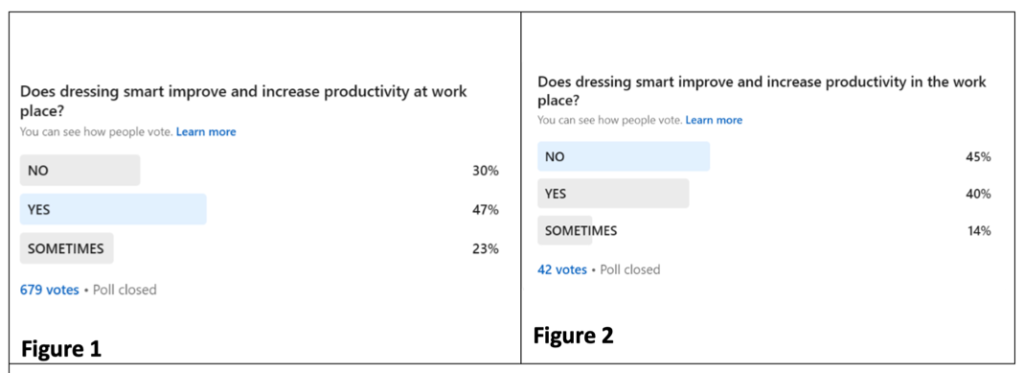Educational
Dressing Smartly to Work: An Examination of its Effect on Work Productivity
March 22, 2023
Authors: Emmanuel Ajoku and Eli Hamadimann
Abstract: The link between dressing smartly to work and productivity has been a long-standing
debate in the workplace. This article explores the effect of dressing smartly to work on work
productivity, with particular attention paid to the education and construction industries. The study
also sought to test the hypothesis that dressing smartly to work does not increase productivity at
work. A poll was conducted on LinkedIn to gather respondents’ views from various professions, and
the results analyzed using statistical tests. The results indicate that there is a relationship between
dressing smartly to work and increased productivity, although not a 100% relationship. The study
concludes that dressing smartly to work can lead to improved productivity in some industries and
recommends that organizations consider implementing dress codes and uniforms as a means of
improving employee productivity.
Introduction: Dressing smartly to work has been a topic of debate for a long time. While some
people argue that it has a positive effect on productivity, others are of the opinion that it is
irrelevant to work output. The education and construction industries are two sectors where dress
codes and uniforms are often enforced, with the belief that they create a sense of professionalism
and pride. This study seeks to examine the effect of dressing smartly to work on productivity, with a
focus on these two industries.
Methodology: The study involved conducting a poll on LinkedIn to gather the views of respondents
from various professions. The first poll was vertical (figure 1), with respondents belonging to the
same or similar professions. The second poll was horizontal (figure 2), with respondents from
different professions. The data collected from the polls were analyzed using statistical tests to
determine if there was a relationship between dressing smartly to work and increased productivity.

The results were discussed with Dr. Eli Hamadimann, an academic and industry expert in the field of
employee productivity and performance.
Dr. Eli has strong experience in the education and construction sectors and has noticed that attention to detail is one of the most important factors in achieving success. This attention to detail applies not only to the products that a company produces, but also to the way employees present themselves while working.
Over many years of working in the construction and education industries, Dr. Eli has observed a strong correlation between uniforms and improved productivity. In these industries, the way that employees present themselves can have a significant impact on their performance and the performance of the organization.
Analysis of the Results
Using the 697 votes in figure 1 as the control poll, the null hypothesis is “There is no evidence that dressing smartly to work increases productivity at work.”
Ho: µ = 0.3 or 30%
H1: µ ≠ 0.3 or 30%
Results: The results of the polls indicate that there is a relationship between dressing smartly to work and increased productivity, although not a 100% relationship. The first poll had 697 votes, with 30% in favor of the hypothesis that dressing smartly to work does not increase productivity. The second poll had 42 votes, with 40% in favor of the statement that dressing smartly to work increases productivity. Although 45% voted NO in the second poll, statistical testing suggest evidence to reject the null hypothesis at both 5% and 10% significance levels.
Discussion: The study’s findings suggest that dressing smartly to work can lead to increased productivity in some industries, particularly those where uniforms and dress codes are enforced. The education and construction industries benefit from the sense of professionalism, pride, and unity that uniforms and dress codes create. Workers in these industries are more likely to take their work seriously when dressed in a uniform, leading to improved productivity. However, it is essential to note that dressing smartly to work is not the only factor that affects productivity. Other factors, such as job satisfaction, work environment, and work-life balance, emotional wellbeing also play a significant role.
Dr. Eli further explained that uniforms in the construction industry can also create a sense of identity and pride in the organization. When employees are dressed in a uniform, they are representing their company and their work. This can create a sense of pride and ownership, which translates to improved productivity and a higher quality of work.
Conclusion: The study’s findings support the notion that dressing smartly to work can lead to increased productivity, particularly in industries where uniforms and dress codes are enforced. Organizations in these industries should consider implementing dress codes and uniforms as a means of improving employee productivity. However, it is essential to note that dressing smartly to work is not a one-size-fits-all solution, and other factors must also be considered. In conclusion, the study highlights the importance of attention to detail in achieving success in the workplace.



